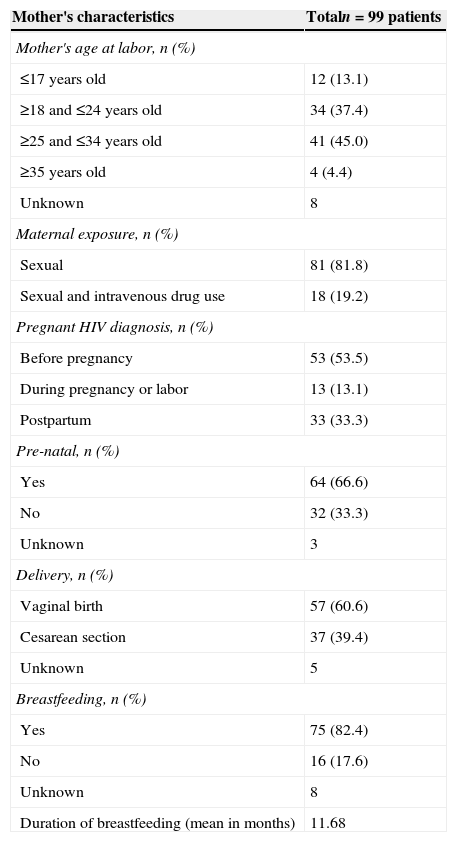The increment of HIV transmission involving the female population of childbearing age favors HIV vertical transmission.1 Programs for the prevention of mother-to-child-transmission (PMTCT) of HIV are part of the solution to eliminate new pediatric HIV infections and that can reduce the risk of MTCT to fewer than 2%.2
Herein we report missed opportunities for preventing perinatal HIV infection abstracted from medical records of a cohort of patients. Vertically HIV-infected infants followed up from birth or from the time of diagnosis receiving care at the referral services of Campo Grande city, in Midwest Brazil, between 1993 and 2014 were included. Patients who died during the study period were excluded from the analysis due to insufficient information in the medical records.
One hundred forty-one patients were identified until 2014, 99 were eligible for inclusion and 42 died during the study period. Most of the children were diagnosed owing to their parents’ HIV diagnoses (p<0.001), including one patient diagnosed at 127 months old. One teenager was diagnosed at 144 months because of the death his older brother.
Seventy-six mothers (96.2%) had not received ARV prophylaxis during pregnancy, while 74 (92.5%) had not used prophylaxis during labor, including two women who had received ARVT during pregnancy. Moreover, 91 (91.9%) children had not received prophylaxis ARV. Although 66.0% of HIV infections in the women had been diagnosed before delivery (Table 1), 82.4% of the newborns were breastfed. Despite lack of ARV prophylaxis, most of the patients (52.5%) were between 16 and 24 years old in 2014.
Characteristics of HIV-positive mothers of infants infected by vertical transmission, Campo Grande, Brazil.
| Mother's characteristics | Totaln=99 patients |
|---|---|
| Mother's age at labor, n (%) | |
| ≤17 years old | 12 (13.1) |
| ≥18 and ≤24 years old | 34 (37.4) |
| ≥25 and ≤34 years old | 41 (45.0) |
| ≥35 years old | 4 (4.4) |
| Unknown | 8 |
| Maternal exposure, n (%) | |
| Sexual | 81 (81.8) |
| Sexual and intravenous drug use | 18 (19.2) |
| Pregnant HIV diagnosis, n (%) | |
| Before pregnancy | 53 (53.5) |
| During pregnancy or labor | 13 (13.1) |
| Postpartum | 33 (33.3) |
| Pre-natal, n (%) | |
| Yes | 64 (66.6) |
| No | 32 (33.3) |
| Unknown | 3 |
| Delivery, n (%) | |
| Vaginal birth | 57 (60.6) |
| Cesarean section | 37 (39.4) |
| Unknown | 5 |
| Breastfeeding, n (%) | |
| Yes | 75 (82.4) |
| No | 16 (17.6) |
| Unknown | 8 |
| Duration of breastfeeding (mean in months) | 11.68 |
Since 1997, voluntary prenatal HIV testing ought to be offered in Brazil. The fact that 43% of the children in this cohort were born before 1997 contributed to the majority of pregnant women having been diagnosed after delivery. On the other hand, 57% of the children were born after 1997 and their HIV-infected mothers could have been diagnosed during pregnancy.
Furthermore, women who were receiving ARVT during pregnancy and did not use prophylaxis during labor, as well as women who were aware of their HIV status before pregnancy and had not undergone Cesarean delivery raises the issue of communication among HIV care services, antenatal care, maternity services, and the involved woman. Pregnant HIV diagnosis occurred before pregnancy in more than half of the patients and even though the Brazilian Guidelines for Prevention of HIV Transmission were not applied.
Regarding breastfeeding, in settings such as sub-Saharan Africa, where HIV-infected mothers must decide between the reduction of HIV transmission and the risk of death,3 their choice to breastfeed is understandable. In Brazil, since 2002, formula has been provided for infants born to HIV-infected mothers.
In conclusion, the recommendations from the Brazilian National STD/AIDS Program of the Ministry of Health for the reduction of HIV vertical transmission are not being correctly applied; there is lack of integration among health services, and effective biomedical interventions seem not be effective without concomitant interventions on the social environment.
FundingThere was no financial support.
Conflicts of interestThe author declares no conflicts of interest.





